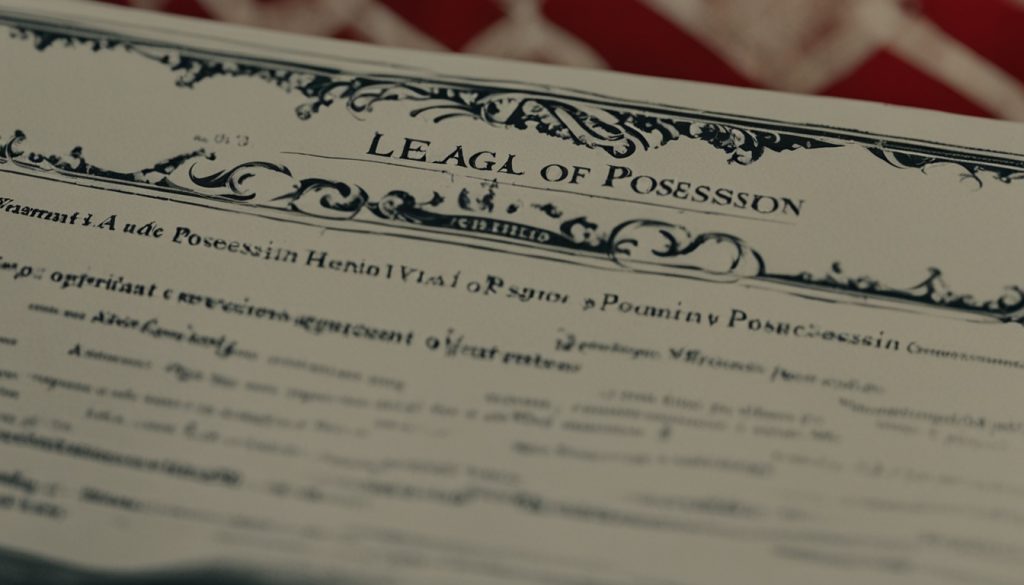As a landlord, the prospect of evicting a tenant can be daunting. However, if you find yourself in a situation where you need to regain possession of your property, it’s crucial to understand the legal process. The question is, do you know the proper steps to take when evicting a renter in the UK? The answer may surprise you.
Navigating the complexities of tenant eviction can be challenging, but with the right knowledge, you can ensure a smooth and lawful transition. This comprehensive guide will walk you through the step-by-step process, from understanding the legal framework to executing the eviction with the help of bailiffs. By the end, you’ll be equipped with the necessary tools to handle this delicate situation effectively.
So, are you ready to learn how to evict a renter in the UK? Let’s dive in and uncover the secrets to a successful, legally-sound eviction process.
Understanding the Legal Framework for Evictions
The process of evicting a tenant in the United Kingdom is governed by a specific legal framework. At the heart of this framework is the Housing Act 1988, which lays out the rights and obligations of both landlords and tenants when it comes to terminating a tenancy agreement.
The Housing Act 1988 and Its Provisions
The Housing Act 1988 introduced the concept of assured shorthold tenancies, which have become the most common type of residential tenancy agreement in the UK. These tenancies can be either ‘periodic’ (with no fixed end date) or ‘fixed-term’ (with a specific start and end date).
The Act outlines the strict legal process that landlords must follow when seeking to evict a tenant, including the grounds on which they can do so and the required notice periods. Failure to adhere to these procedures can result in consequences such as compensation for unlawful eviction.
Tenants’ Rights and Landlords’ Obligations
- Tenants have the right to remain on the property for the duration of the tenancy agreement unless the landlord can demonstrate valid grounds for eviction.
- Landlords are obligated to provide their tenants with a written tenancy agreement that clearly outlines the terms and conditions of the tenancy.
- Landlords must also fulfill certain legal responsibilities, such as maintaining the property in a safe and habitable condition and protecting their tenants’ deposits.
Understanding the legal framework for evictions, including the provisions of the Housing Act 1988 and the respective rights and obligations of landlords and tenants, is crucial for any property owner seeking to navigate the eviction process effectively and in compliance with the law.
Section 21 Notices: The ‘No-Fault’ Eviction Route
When it comes to regaining possession of a rental property in the UK, landlords have two primary options: the ‘no-fault’ eviction route through Section 21 notices, or the ‘fault-based’ eviction route using Section 8 notices. In this section, we’ll delve into the details of Section 21 notices, exploring the eligibility criteria, procedural requirements, and notice periods landlords must adhere to.
Eligibility Criteria for Serving a Section 21 Notice
Landlords can utilise a Section 21 notice to obtain possession of their property if the initial fixed-term period of a tenancy has ended, or if they have a periodic tenancy with no fixed end date. This is often referred to as a ‘no-fault’ eviction, as landlords do not need to demonstrate any specific grounds for terminating the tenancy. However, landlords must ensure they have met certain eligibility criteria before serving a valid Section 21 notice:
- The tenancy must be an assured shorthold tenancy (AST), which is the most common type of residential tenancy in the UK.
- Landlords must have provided the tenant with a valid Energy Performance Certificate (EPC) and the government’s ‘How to Rent’ guide before the tenancy began.
- Any deposit taken from the tenant must have been protected in an approved tenancy deposit scheme.
- Landlords must have provided the tenant with a valid gas safety certificate at the start of the tenancy and annually thereafter.
Procedural Requirements and Notice Periods
In addition to meeting the eligibility criteria, landlords must also adhere to specific procedural requirements and notice periods when serving a Section 21 notice. These include:
- Providing the tenant with at least two months’ written notice to vacate the property.
- Ensuring the notice period does not expire before the end of the fixed-term tenancy or before the end of the first 4 months of a periodic tenancy.
- Serving the notice correctly, either by hand delivery, post, or by a process server.
- Providing the tenant with the prescribed information about their rights and responsibilities.
By understanding the eligibility criteria and procedural requirements for serving a Section 21 notice, landlords can navigate the ‘no-fault’ eviction route efficiently and with confidence, while ensuring their tenants’ rights are respected throughout the process.
How to Evict a Renter Using Section 8 Notices?
Landlords in the UK may utilise a Section 8 notice to commence eviction proceedings if a tenant has failed to meet the terms of their tenancy agreement. This process involves specific grounds for eviction, notice periods, and documentation requirements that landlords must adhere to.
Grounds for Serving a Section 8 Notice
The primary grounds for serving a Section 8 notice include:
- Rent arrears: Tenants who have fallen behind on rent payments may face eviction.
- Breaches of the tenancy agreement: This could involve property damage, anti-social behaviour, or other violations of the contract.
- Lack of right to rent in the UK: Landlords are required to ensure their tenants have the right to legally reside in the country.
Notice Periods and Documentation Requirements
The notice period and documentation needed for a Section 8 notice can vary depending on the specific grounds for eviction:
- Rent arrears: If the tenant is at least two months behind on rent, the landlord must provide a minimum of two weeks’ notice.
- Tenancy agreement breaches: The notice period is typically between two weeks and two months, depending on the severity of the breach.
- Lack of right to rent: Landlords must provide the tenant with a minimum of two weeks’ notice and submit relevant documentation to prove the tenant’s immigration status.
It’s crucial for landlords to carefully follow the correct procedures and provide the appropriate notice periods to ensure a successful eviction using a Section 8 notice.

| Grounds for Eviction | Minimum Notice Period | Required Documentation |
|---|---|---|
| Rent arrears (2+ months) | 2 weeks | Rent statements, payment records |
| Tenancy agreement breaches | 2 weeks to 2 months | Evidence of breach, written warnings |
| Lack of right to rent | 2 weeks | Proof of immigration status |
Court Proceedings and Possession Orders
If a tenant refuses to vacate the property after the notice period expires, the landlord must initiate court proceedings to remove the tenant. The court can then issue various types of possession orders, each with its own set of requirements and implications.
Standard Possession Orders
A standard possession order is typically granted when the tenant has fallen into rent arrears. The court will consider factors such as the amount of rent owed and the tenant’s ability to clear the debt. If the order is granted, the tenant will be given a set period, usually 14 days, to vacate the property.
Accelerated Possession Orders
In cases where the landlord is not claiming rent arrears, they can apply for an accelerated possession order. This process is generally faster, as the court does not need to consider the tenant’s financial circumstances. The tenant will again be given a specified timeframe, typically 14 days, to leave the property.
Suspended Possession Orders
In some instances, the court may grant a suspended possession order if the tenant can demonstrate that they will be able to clear the rent arrears and continue paying rent. This allows the tenant to remain in the property, provided they adhere to the agreed payment plan.
Exceptional Hardship
The court can also extend the possession order period up to a maximum of 42 days if the tenant can prove they would suffer ‘exceptional hardship’ if possession was granted in the standard 14-day period. This provides the tenant with additional time to make alternative arrangements.
The court’s decision on possession orders is crucial in the eviction process, as it determines the timeline and the circumstances under which the tenant must vacate the property. Understanding the different types of possession orders and their respective requirements is essential for landlords navigating the legal framework for evictions.

Executing an Eviction: Warrants and Bailiffs
Once a possession order has been granted by the court, the landlord’s next step is to apply for a warrant of possession. This legal document authorises a bailiff to attend the property and use reasonable force, if necessary, to evict the tenant. The process of obtaining a warrant and executing the eviction can be complex, with specific procedures that landlords must follow to avoid potential legal pitfalls.
Applying for a Warrant of Possession
If the tenant has not vacated the property by the date specified in the possession order, the landlord must apply to the court for a warrant of possession. This typically involves completing an application form and submitting it to the court, along with any required fees. The court will then arrange a date for the bailiff to attend the property and carry out the eviction.
Landlords should be aware that they cannot change the locks or forcibly remove a tenant from the property without a valid warrant of possession. Doing so could be considered an unlawful eviction, which could result in the tenant being awarded compensation.
The Role of Bailiffs in the Eviction Process
The bailiff’s role in the eviction process is to attend the property on the specified date and use reasonable force to remove the tenant, if necessary. This may involve breaking into the property, changing the locks, and disposing of any tenant belongings left behind.
Landlords should be present during the eviction, but they should not attempt to physically remove the tenant themselves. The bailiff is responsible for ensuring the eviction is carried out in a lawful and orderly manner. Landlords who interfere with the bailiff’s duties or attempt to take matters into their own hands could face legal consequences.
Following the eviction, the landlord is responsible for disposing of any tenant belongings left in the property. This must be done in accordance with the law, and the landlord may need to store the belongings for a specified period before they can be disposed of or sold.

Conclusion
In summary, the eviction process in the UK, though relatively straightforward if the proper procedures are followed, is set to undergo significant changes in the near future. The upcoming Renters Reform Bill is poised to abolish Section 21 ‘no-fault’ evictions, ushering in a new tenancy system that landlords must familiarise themselves with.
While the current eviction process can cost landlords between £1,000 and £3,000, the introduction of these reforms may impact the overall costs and timeline. Landlords are advised to stay informed on the progress of the Renters Reform Bill and be prepared to adapt to the new requirements, which may include updated notice periods and additional documentation.
To mitigate the hassle and expense of evictions, landlords may also wish to consider rent guarantee schemes. These schemes can provide peace of mind and financial security, ensuring that rental payments are made on time and avoiding the need for costly and time-consuming eviction proceedings.
FAQ
What are the grounds for serving a Section 8 notice to evict a tenant?
Landlords can serve a Section 8 notice if the tenant has missed rent payments, damaged the property, or otherwise breached the tenancy agreement. Grounds can include serious anti-social behaviour, lack of right to rent in the UK, and non-payment or serious rent arrears.
What happens if the tenant still refuses to leave after the possession order is granted?
If the tenant has not vacated the property after the possession order has been granted, the landlord must apply to the court for a warrant of possession. This allows a bailiff to attend the property on a fixed date and use reasonable force to evict the tenant.
What are the upcoming changes to the eviction process in the UK?
The upcoming Renters Reform Bill is set to bring significant changes to the eviction process, including the abolition of Section 21 ‘no-fault’ evictions. Landlords will need to stay informed on the progress of this legislation and be prepared for the new requirements.






